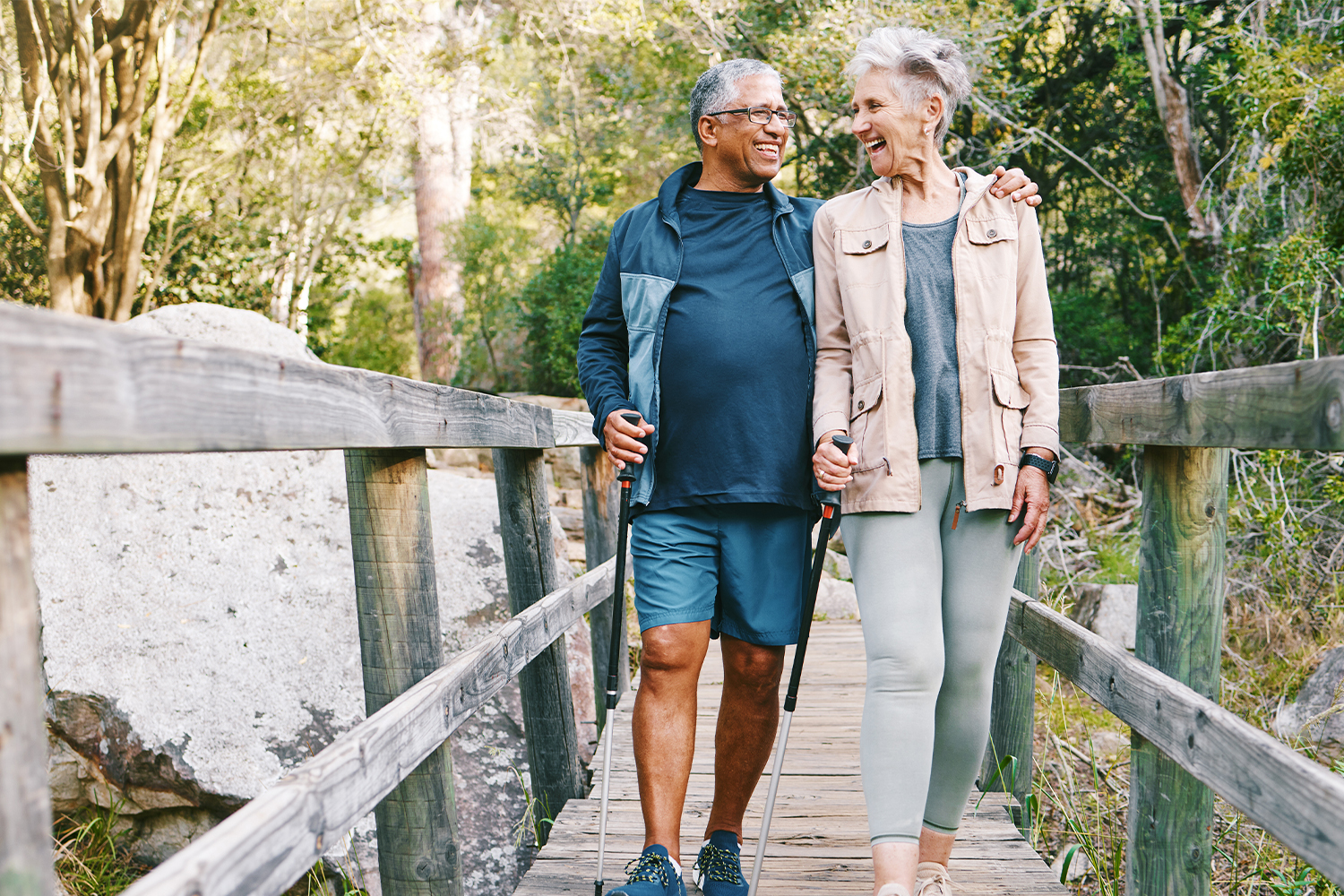As a senior, you may be looking for ways to improve your health, manage stress, and fight off diseases like diabetes and heart disease, for which older adults have an elevated risk. There is a common misconception that walking isn’t intense enough to provide the cardiovascular benefits that other aerobic exercises do. But the truth is, walking is one of the best and easiest ways to exercise: It’s simple, easy on the joints, and doesn't require special equipment or facilities. But more than that, walking regularly can improve longevity, help you maintain your independence, lower your blood sugar, and so much more.
Because of the low fall and injury risk, walking is a great option for staying active! Here are some other proven ways that walking can help you feel your best, physically and mentally.
Walking is a great form of exercise that has many benefits for seniors.
Seniors who can't go to the gym or participate in other types of physical activity may find walking easier than any other type of exercise because it doesn’t require any equipment or special skills. Walking is also great for those with chronic conditions such as arthritis, osteoporosis, fibromyalgia, or diabetes.
Walking provides all the benefits of aerobic exercise, like strengthening your heart and lungs and improving stamina—which makes it perfect for seniors looking to stay healthy without putting too much strain on their bodies.
Walking regularly can help you live longer.
Studies show that regular walking can help you live longer by reducing the risk of death from heart disease. In fact, people who walk at least three times per week have lower death rates than those who walk less often or not at all. In addition to reducing your risk of chronic conditions such as heart disease and diabetes, regular walking helps maintain a healthy weight,which is also vital for overall good health.
Walking improves circulation and lowers blood pressure.
Walking is a great way to improve circulation, which helps lower blood pressure and reduce the risk of heart disease. When you walk, your heart rate increases. This causes your blood vesselsto expand, allowing more oxygenated blood to flow through them and out into the rest of your body. If you are someone with cold hands or feet, walking could be the answer!
Walking helps control cholesterol levels and boosts heart health.
The American Heart Association recommends that adults engage in 30 minutes of moderate-intensity aerobic activity at least five days per week. Walking is one of the best ways to fulfill thisrecommendation, as it's low impact and can be done almost anywhere.
If you're not sure where to begin, give this easy walking workout a try: Start with a brisk walk for 5 minutes, then increase your speed until you reach a pace that feels just under a light jog (around 4-5 miles per hour), and continue for 20 minutes; finish off by returning to your starting speed for five more minutes. It's that simple!
In addition to keeping your heart healthy, regular exercise can also help lower cholesterol levels—a good thing since high cholesterol isn't just bad for the heart but can also cause depression and memory loss later in life—and prevent other serious illnesses such as diabetes and cancer.
Walking is less likely to result in injury than other types of exercise.
Walking is a low-impact exercise that is safe for people of all ages. It's easy to do and easy on the joints. Walking is also a great way to get in shape without putting too much stress on the body. But wait—there’s more: Getting outdoors for your walk can also improve your body’s natural Circadian rhythm, or your internal clock, which is responsible for making sure you feel hungry and sleepy at the right times throughout the day.
Walking can lead to a more positive self-image.As you start walking consistently, you may find that your sense of self is improving. From feelingmore confident to improved energy levels, the benefits of walking cannot be overstated. You may also start to feel a connection with the community around you, which can lead to a deeper sense of belonging. Walking with friends or family is a great way for older adults to get together and stay connected.
As a bonus, walking can also do wonders for mental health and is linked to decreased anxiety and stress.
Walking is a good way to maintain your ideal body weight.
According to the National Institutes of Health, the average person who walks for 30 minutes burns just over 100 calories. If you want to burn even more calories, increase the time you spend walking. For example, if two hours of walking burns about 500 calories and four hours burns about 800 calories, then eight hours would burn 1,600 calories. This means that with just two miles of brisk walking in a day (about 30 minutes), an individual could lose one pound per week by maintaining their current diet and activity level!This makes walking an effective and convenient way for older adults to lose or maintain a healthy weight since it does not require any special equipment or machines—just shoes and clothing appropriate for outdoor activity in your area!
Exercise Can Be Simple
There are many exercise options out there, which can lead to feeling overwhelmed and unsure of what to implement or how often. Walking takes the guesswork out of the equation and is the easiest, safest, and most versatile way to reap copious health benefits that help you feel your best, physically and mentally. Using wearable tech to track your steps can make walking a fun, engaging way to keep moving and get more steps than the day before. So don’t be afraid to get outdoors and get those steps in.




